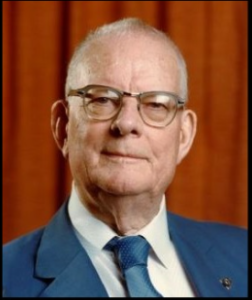In our previous article , we learnt about the history of Kanban which started in the crowded streets of Japanese town in the 15th Century and touched upon the brilliance of Taiichi Ohno who initiated the Kanban evolution from the floors of Toyota Production System (TPS) .
As we explored above two historical events which happened centuries apart , there seemed to be a pattern of principles that emerged , which raised the question around anyone who might have researched these patterns .
In order to answer that question , it is important at this stage to learn about William Edwards Deming .
Deming’s initial journey started as an assistant professor of physics at the Colorado School of Mines, he simultaneously obtaining a master’s degree in mathematics and physics at the University of Colorado in 1924 and later went to Yale and received his doctorate in mathematical physics . For the next 10 years Deming focused on lecturing and writing in mathematics, physics and statistics.
During his time with the United States Department of Agriculture , Deming familiarised himself with the work of Walter Shewhart , who was working on application of statistical techniques on manufacturing process . Deming then became curious on applying the same techniques to non-technical process like management activities . He experimented with this idea when he joined US Census Bureau in 1939 which resulted in improvement in productivity. Deming wanted to share this knowledge to the wider audience and started to run courses on the evolving methods of statistical process control and developed a cycle for quality control which was further updated to become Deming cycle . This further evolved into what is now known as PDCA ( Plan–Do–Check–Act ) .
After the second world war , Deming was posted as an advisor to the Japanese Census and during this time he continued his career of lecturing on statistical methods and company-wide quality: and these combination of techniques now known as Total Quality Management (TQM) had begun .

Source: The W Edwards Deming Institute
Deming is known for spreading statistical quality control, as well as helping to put quality on the industry agenda. He is also the author of 14 key principles for Total Quality Management.
This now leads to Deming’s 14 points which is one of the foundation principles that enabled Lean evolution .
He also emphasised on showing management how to create an environment for success .Deming focused on Culture and his System of Profound Knowledge ,especially effective for knowledge work. Deming’s System of Profound Knowledge made up of four components as lenses through which we see, and all four are related to each other
By understanding the system, participants can operate in a way that everyone (management, performers, customers, and suppliers) benefits. Understanding the system is difficult – typically everyone views the system from their own siloed perspective. Understanding the system requires that everyone rise above their siloed perspective to understand the system in the context of the overall goal, what the organization does to achieve this goal, the boundaries and constraints, and to share the sensing and feedback mechanisms.
There seems to be an advantage in learning about history to start understanding the system , find patterns of variation in the system but more importantly understand the human psychology which is at the heart of the system . Kanban process today is an example of a simple implementation of Deming’s philosophy .
This raises another question , What is the relation between the above mentioned theories to the legacy on Quality and Continuous improvement by Toyota corporation ? Even after eight decades , what fascinates researchers about Toyota Production System ?
Let us explore the above question in detail in The Evolution of Kanban – Part 3 .